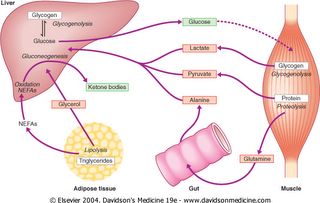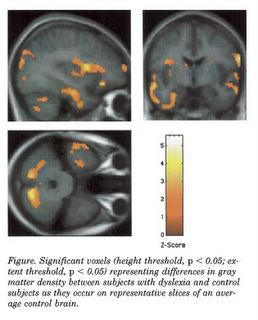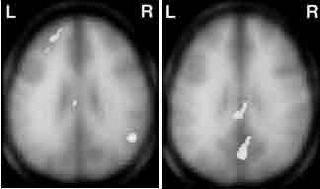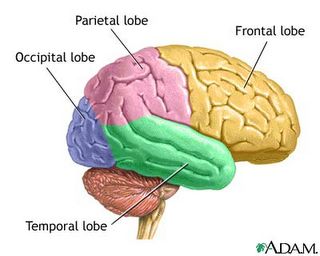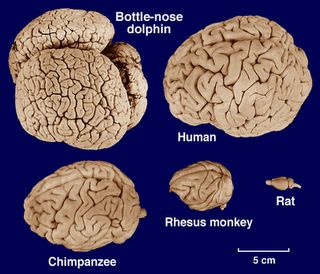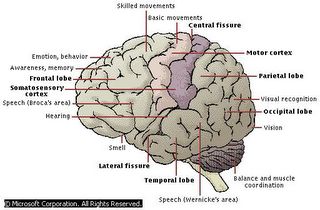To Kink:
You are right to a small extent. Anorexic people and people who starve themselves to lose weight to maintain their figure (i.e supermodels) may damage the brain, regardless whether it is white or gray matter which is degenerated.
When the body is under nourished, it has a lack of carbohydrates and thus has a low source of glucose. When this happens, cells, tissues and organs in the body feed back to the brain that more glucose is needed. The brain itself also runs only on pure glucose and thus also determines more glucose is needed. However, there is no source of glucose found in the body from carbohydrates and thus other methods must be employed quickly to obtain glucose to prevent the body from suffering a neurogenic shock.
An important process to note is the process of gluconeogenesis. Gluconeogenesis refers to the production of glucose by the liver from other substances beside carbohydrates, thus referring to proteins and fats.
Muscle tissue and triglycerides (fats) are broken down to obtain glucose. Triglycerides are broken down into glycerol through lipolysis. Non-esterified fatty acids mix with the glycerol to form glucose and toxic ketone bodies. These ketone bodies, produced in the process of ketoacidosis, are toxic to the body and can lead to major organ failure.
The proteins in muscles are broken down through proteolysis to form pyruvate. Glycogen stored in the muscles is also broken down through glycogenolysis to form lactate. Together with alanine absorbed assimilation, lactate, pyruvate and alanine combine to form glucose. Thus we can see, glucose can be obtained from muscle and fat cells, however detrimental it might be.
Muscle and fat cells all over the body may be broken down for this purpose. However, the muscles and fat cells broken down are mostly cells which do not constitute any major organ in the body. It would be dangerous and suicidal if the body breaks down the proteins making up the heart just to supply glucose to the brain. In extreme cases of hypoglycemia (low blood glucose level), the brain would then be forced to shut down organs of the body, beginning with the least important. The brain’s fatty deposits may also be broken down. (N.B Brain is composed of 66% triglycerides). When the body cannot overcome the lack of glucose, it will fall into neurogenic shock, triggering sudden hypotension and stopping all organ activity.
Thus, in my opinion, it is likely that the person may suffer from ketone poisoning and muscle degeneration, but very unlikely that the brain would degenerate with starvation.
Tuesday, September 20, 2005
Monday, September 19, 2005
Neurotic Enzyme that regulates weight?
"According to the 'Wall Street Journal', researchers at Harvard have found an enzyme in the brain that regulates obesity. They said if it wasn't for our brains, we would all be thin. That's why supermodels are so skinny. No brain, no gain." -Jay Leno
The first part is true. The second part, a whole load of guano.
Well, in this blog entry I will prove that indeed there is an enzyme in the brain regulating obesity. However, I do not belief that Harvard researchers said in their paper that enzymatic regulation of weight results in supermodels being skinny. It is an apparent bias and is utter defamation to view supermodels in that light.
Scientists have found an enzyme in the hypothalamus of the brain called AMP-Kinase (AMPK) which complements leptin (a hormone that is produced by fat cells). Leptin inhibits the production of AMP-Kinase. Thus we can say that the more adipose tissues a person has, the more leptin produced which results in lower levels of AMP-Kinase. This will allow the body to cut down on the production of fatty acids and detrimental substances leading to obesity. The levels of AMP-Kinase are directly proportionate to the obesity of the human. As can be seen from the chart below, an increase in the amount of AMP-Kinase would bring about fatty acid synthesis, cholesterol synthesis, fatty acid synthesis, lipolysis and many other detrimental effects to the body which may in turn cause atherosclerosis or angina.
However, it is important to note that obesity means that the AMP-Kinase is immune to the effect of leptin. Thus, regardless of the amount of leptin produced, AMP-Kinase will still be produced and thus, obesity and weight gain sets in. AMP-Kinase immunity to leptin may be genetic in nature, thus some people are “born fat”.
Regarding supermodels, the amount of gray matter, or rather intelligence of their brain is not in any way linked to the production of AMP-Kinase thus completely refuting Jay Leno’s groundless claim. But a conclusion that supermodels’ AMP-Kinase are not leptin resistant can be drawn.
The first part is true. The second part, a whole load of guano.
Well, in this blog entry I will prove that indeed there is an enzyme in the brain regulating obesity. However, I do not belief that Harvard researchers said in their paper that enzymatic regulation of weight results in supermodels being skinny. It is an apparent bias and is utter defamation to view supermodels in that light.
Scientists have found an enzyme in the hypothalamus of the brain called AMP-Kinase (AMPK) which complements leptin (a hormone that is produced by fat cells). Leptin inhibits the production of AMP-Kinase. Thus we can say that the more adipose tissues a person has, the more leptin produced which results in lower levels of AMP-Kinase. This will allow the body to cut down on the production of fatty acids and detrimental substances leading to obesity. The levels of AMP-Kinase are directly proportionate to the obesity of the human. As can be seen from the chart below, an increase in the amount of AMP-Kinase would bring about fatty acid synthesis, cholesterol synthesis, fatty acid synthesis, lipolysis and many other detrimental effects to the body which may in turn cause atherosclerosis or angina.
However, it is important to note that obesity means that the AMP-Kinase is immune to the effect of leptin. Thus, regardless of the amount of leptin produced, AMP-Kinase will still be produced and thus, obesity and weight gain sets in. AMP-Kinase immunity to leptin may be genetic in nature, thus some people are “born fat”.
Regarding supermodels, the amount of gray matter, or rather intelligence of their brain is not in any way linked to the production of AMP-Kinase thus completely refuting Jay Leno’s groundless claim. But a conclusion that supermodels’ AMP-Kinase are not leptin resistant can be drawn.
Sunday, September 18, 2005
Dyslexic?
In response to Mr Tay Wenbin's question.
Dyslexia
Dyslexia is a neurological, genetic based disease affecting 5% of the population. The cause of dyslexia is genetic based which means mutations in germ line (sex cells) can cause an offspring to have dyslexia. Dyslexic people have compromised reading and writing abilities and intelligence which is significantly lower than which would be predicted by his general level of intelligence. This is because of decreasing amounts of gray matter in the parietal and temporal lobe (please refer to above image). In layman terms, the amount of gray matter in the brain is directly proportionate to the intelligence of a human.
There are many characteristics of Dyslexia. Some of which are silent characteristics, which means that they are not shown outwardly. Some of these characteristics are reading and writing disabilities and complaining of dizziness, headaches or stomach aches while reading. This entry will not go into the further symptoms of dyslexia.
Dyslexic people tend to look at words as pictures and thus are slower in comprehending.
Treatment of dyslexia is based mainly on phonological training, which involves breaking down and rearranging sounds to produce different words.
As of my knowledge, dyslexic people are born dyslexic from birth. No non-dyslexic turns can turn dyslexic at any point of his/ her life.
I hope this answers your question. If you have any feedback, please tag on my tagboard.
Dyslexia
Dyslexia is a neurological, genetic based disease affecting 5% of the population. The cause of dyslexia is genetic based which means mutations in germ line (sex cells) can cause an offspring to have dyslexia. Dyslexic people have compromised reading and writing abilities and intelligence which is significantly lower than which would be predicted by his general level of intelligence. This is because of decreasing amounts of gray matter in the parietal and temporal lobe (please refer to above image). In layman terms, the amount of gray matter in the brain is directly proportionate to the intelligence of a human.
There are many characteristics of Dyslexia. Some of which are silent characteristics, which means that they are not shown outwardly. Some of these characteristics are reading and writing disabilities and complaining of dizziness, headaches or stomach aches while reading. This entry will not go into the further symptoms of dyslexia.
Dyslexic people tend to look at words as pictures and thus are slower in comprehending.
Treatment of dyslexia is based mainly on phonological training, which involves breaking down and rearranging sounds to produce different words.
As of my knowledge, dyslexic people are born dyslexic from birth. No non-dyslexic turns can turn dyslexic at any point of his/ her life.
I hope this answers your question. If you have any feedback, please tag on my tagboard.
Pyrexia
I shall deviate from Neurology to talk about something that many of my friends are suffering from now.
Pyrexia (common name: Fever)
Fever is a common term to describe a medical symptom in which a human's internal body temperature rises to temperatures above normal. Fever is not a neurological disease, but can be brought about by one. Fever is brought about by pathogens (biological agent which can cause disease to its host). It is a postive feedback mechanism which opposes the homeostatic negative feedback thermal regulatory mechanism. As with any positive feedback mechanism, fever aims to achieve a normal body condition by raising the internal body temperature to denature enzymes which enable the pathogen to work, indirectly killing the pathogen itself. Thus fever cannot be labelled as a disease, but rather as a symptom and as the body's defense mechanism towards pathogens.
As mentioned above, Fever is caused by infections and thus is not termed a disease. However, there are drugs to stop the development of fever. These drugs are called antipyretics. Acetaminophen or Paracetamol (Panadol) are examples of it. These drugs inhibit the production of the cyclooxygenase enzyme responsible for inducing the increase in body temperature.
However, antipyretics only suppress the fever and stops the positive feedback mechanism. They do not inhibit the source of it. Thus, a patient who is immunodeficient may be on antipyretics alone for months without antibiotics and die. Antibiotics must be prescribed together with the antipyretics so as to minimize the fever and to eliminate the source of infection which results in the fever. Thus it is absolutely necessary to see a doctor to obtain antibiotics when fever arises. However, a patient may recover totally without the use of antibiotics as the body's immune system will produce its own antibodies to combat the infection, but the time for recovery would be significantly longer.
Pyrexia (common name: Fever)
Fever is a common term to describe a medical symptom in which a human's internal body temperature rises to temperatures above normal. Fever is not a neurological disease, but can be brought about by one. Fever is brought about by pathogens (biological agent which can cause disease to its host). It is a postive feedback mechanism which opposes the homeostatic negative feedback thermal regulatory mechanism. As with any positive feedback mechanism, fever aims to achieve a normal body condition by raising the internal body temperature to denature enzymes which enable the pathogen to work, indirectly killing the pathogen itself. Thus fever cannot be labelled as a disease, but rather as a symptom and as the body's defense mechanism towards pathogens.
As mentioned above, Fever is caused by infections and thus is not termed a disease. However, there are drugs to stop the development of fever. These drugs are called antipyretics. Acetaminophen or Paracetamol (Panadol) are examples of it. These drugs inhibit the production of the cyclooxygenase enzyme responsible for inducing the increase in body temperature.
However, antipyretics only suppress the fever and stops the positive feedback mechanism. They do not inhibit the source of it. Thus, a patient who is immunodeficient may be on antipyretics alone for months without antibiotics and die. Antibiotics must be prescribed together with the antipyretics so as to minimize the fever and to eliminate the source of infection which results in the fever. Thus it is absolutely necessary to see a doctor to obtain antibiotics when fever arises. However, a patient may recover totally without the use of antibiotics as the body's immune system will produce its own antibodies to combat the infection, but the time for recovery would be significantly longer.
Thursday, September 15, 2005
BrainFreeze
Brain Freeze is a term used to describe a headache or a throbbing pain felt after consuming cold beverages or foods such as ice-creams. The chances of this happening is increased as rate of consumption is increased.
The scientific term for Brain Freeze is Temporal Neurocranial Vasodilation.
When cold food touches the roof of the mouth, or anywhere near the Parotid gland, the Sphenopalatine Ganglia nerves there are triggered. They send a signal to the brain that it is in a very cold environment. Homeostatic functions are induced. Negative feedback causes the blood vessels in the brain to vasodilate and swell for about 30 seconds to provide the brain with the necessary heat. The swell presses against the cranial nerves, inducing pain.
A simple cure to it would be to move your tongue to the roof of your mouth when you suffer from Neurocranial Vasodilation. This would cause greater warmth to the Sphenopalatine Ganglia nerves and thus, they will not send impulses for vessels in the brain to vasodilate.
The scientific term for Brain Freeze is Temporal Neurocranial Vasodilation.
When cold food touches the roof of the mouth, or anywhere near the Parotid gland, the Sphenopalatine Ganglia nerves there are triggered. They send a signal to the brain that it is in a very cold environment. Homeostatic functions are induced. Negative feedback causes the blood vessels in the brain to vasodilate and swell for about 30 seconds to provide the brain with the necessary heat. The swell presses against the cranial nerves, inducing pain.
A simple cure to it would be to move your tongue to the roof of your mouth when you suffer from Neurocranial Vasodilation. This would cause greater warmth to the Sphenopalatine Ganglia nerves and thus, they will not send impulses for vessels in the brain to vasodilate.
Wednesday, September 14, 2005
Opening of NeuroChowzy
Hello everyone. Welcome to the opening of NeuroChowzy. A little blog which updates on Neurological advances and development. I will be bringing you ideas and interesting facts on the human brain. Feel free to comment, tag on the tagboard. Hope this site will be one of much interest to you guys!
Subscribe to:
Posts (Atom)
